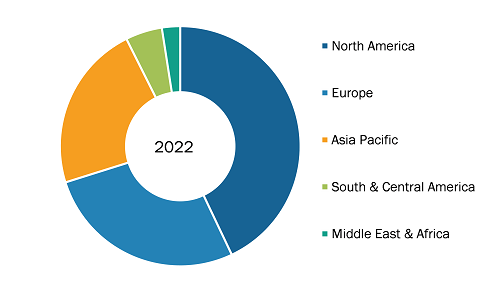Melanoma Type Segment to Dominate Skin Cancer Treatment Market Share During 2022–2030
According to our new research study on "Skin Cancer Treatment Market Size and Forecast (2020–2030), Global and Regional Share, Trend, and Growth Opportunity Analysis," the skin cancer treatment market size is projected to grow from US$ 10,388.57 million in 2022 to US$ 18,277.71 million by 2030; the market is anticipated to record a CAGR of 7.32% from 2022 to 2030. Increasing R&D pipelines focused on skin cancer treatments, the growing prevalence of skin cancer, and rising awareness of skin cancers drive the skin cancer treatment market growth. However, the high cost and adverse effects and problems of the current treatments hinder the growth of the market.
Most players in the oncology drug development industry concentrate on introducing new effective therapies for skin cancer due to the rising incidence of the disease. Businesses are also concentrating on expanding the use of their cancer medications to include skin cancer treatment. In 2022, The US Food and Drug Administration (FDA) approved KIMMTRAK for treating adult HLA-A*02:01-positive uveal melanoma (mUM). Immunocore Holdings plc, a commercial-stage biotechnology company, is leading the development of a novel class of T cell receptor (TCR) bispecific immunotherapies intended to treat various diseases, including cancer, autoimmune, and infectious diseases. In October 2023, Bristol Myers Squibb received the US FDA approval for Opdivo (nivolumab) to treat adult and pediatric patients with completely resected stage IIB or IIC melanoma as an adjuvant. This expands Opdivo's current indication and furthers the company's legacy of offering melanoma patients treatment options. In the coming years, the recent drug approvals and launches will propel the global skin cancer treatment market growth.
Skin Cancer Treatment Market, by Region, 2022 (%)
Skin Cancer Treatment Market Size and Forecasts (2020 - 2030), Global and Regional Share, Trend, and Growth Opportunity Analysis Report Coverage: By Type (Melanoma, Non-Melanoma); Therapy (Immunotherapy, Targeted Therapy, Chemotherapy, Radiation Therapy, Others); End User (Hospitals, Dermatology Clinics, Diagnostic Centers, Others), and Geography
Skin Cancer Treatment Market Strategic Insights by 2030
Download Free Sample
Source: The Insight Partners Analysis
Adverse effects of chemotherapy medications for the treatment of skin cancer, despite an increase in product introductions and treatment choices, hinder the market growth. Adverse effects of chemotherapy medications include fatigue, constipation, and anemia. In addition, side effects of radiation therapy might include damage to the saliva glands, hair loss, and appetite loss. Due to these adverse effects, surgery is the recommended course of treatment for skin cancer. The expected rise in surgical techniques to treat skin cancer negatively impacts the market growth.
Merck & Co., Bristol Mayers Squibb, Novartis AG, Roche, Amgen Inc., GSK, Pfizer Inc., Sun Pharmaceutical, and Regeneron Pharmaceuticals are among the key players operating in the light therapy market. The companies have been implementing organic strategies such as product launches, expansions, and product approvals and inorganic strategies such as partnerships, and collaborations. These strategic initiatives can contribute to company growth and lead to market transformation.
In March 2023, the US FDA approved Zynyz, a humanized monoclonal antibody that targets programmed death receptor-1 (PD-1), for the treatment of metastatic or recurrent locally advanced Merkel cell carcinoma (MCC). Based on tumor response rate and duration of response (DOR), the FDA approved Zynyz under accelerated approval; however, Zynyz's continued approval for this indication may be subject to verification and a description of clinical benefit in confirmatory trials.
The report segments the skin cancer treatment market as follows:
The “skin cancer treatment market analysis” has been carried out by considering the following segments: based on type, therapy, and end user. Based on type, the market is bifurcated into melanoma and non-melanoma. The market, by therapy, is segmented into immunotherapy, targeted therapy, chemotherapy, radiation therapy, and others. By end user, the market is categorized into hospitals, dermatology clinics, diagnostic centers, and others. In terms of geography, the skin cancer treatment market report is segmented into North America (the US, Canada, and Mexico), Europe (the UK, Germany, France, Italy, Spain, and the Rest of Europe), Asia Pacific (China, Japan, India, Australia, South Korea, and the Rest of Asia Pacific), the Middle East & Africa (the UAE, Saudi Arabia, South Africa, and the Rest of Middle East & Africa), and South & Central America (Brazil, Argentina, and the Rest of South & Central America).
The scope of the skin cancer treatment market report entails North America, Europe, Asia Pacific, South & Central America, and the Middle East & Africa. In 2022, North America held the largest global skin cancer treatment market share. The market is segmented based on region: North America, Europe, Asia Pacific, the Middle East & Africa, and South & Central America. North America is the most significant contributor to the market growth owing to the higher incidence of skin cancer in the US and the greater uptake of cancer medications in the country. In addition, inclination of major industry participants toward introducing novel treatments for skin cancer would have a favorable impact on the market expansion in North America in the coming years. As non-melanoma skin cancer is more common in Caucasian populations, North America and Europe account for a significant share of the global market.
Contact Us
Phone: +1-646-491-9876
Email Id: sales@theinsightpartners.com